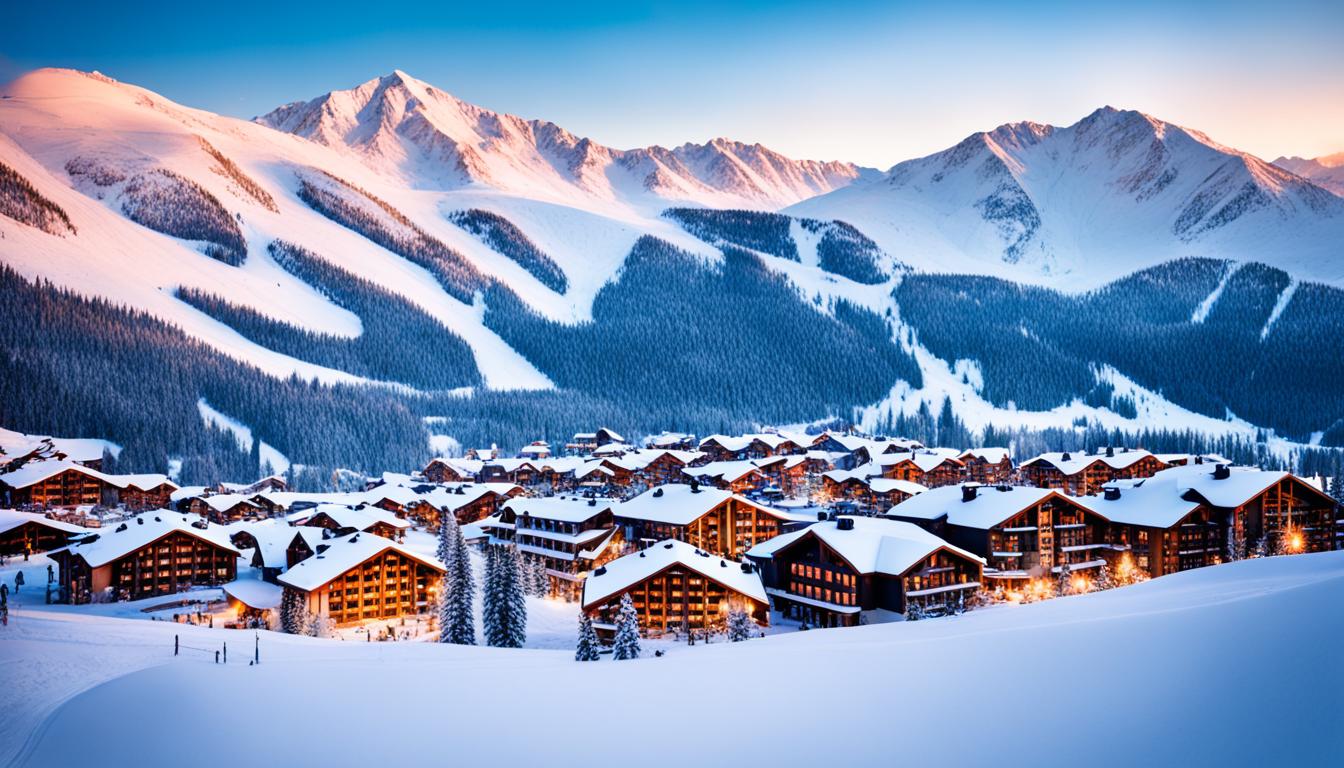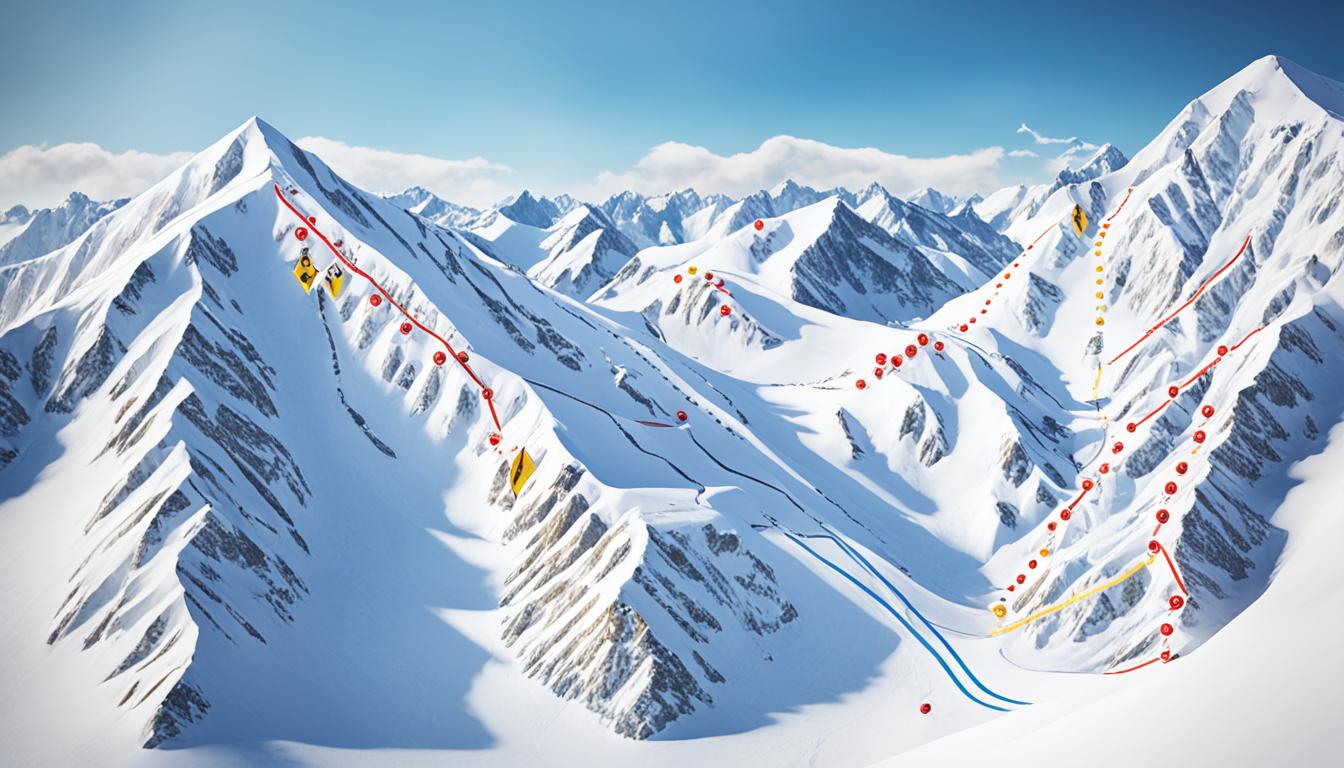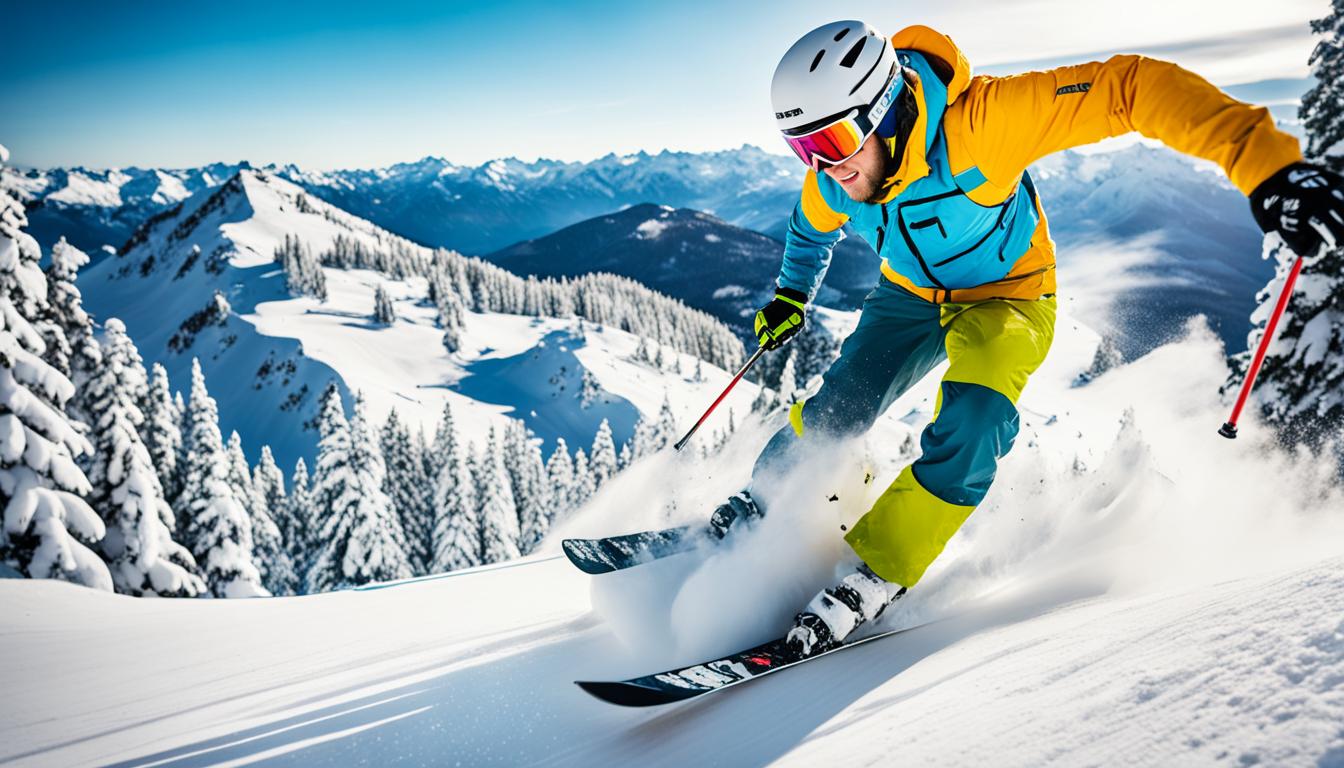Welcome to our guide on forecasting snow! If you’re an avid skier, you know how crucial it is to plan your trips around optimal weather conditions and find the best skiing experiences. Whether you’re hitting the slopes at popular ski resorts or exploring hidden mountain gems, having access to accurate snow forecasts and valuable resources can make all the difference in your skiing adventures.
When it comes to forecasting snow, there are various factors to consider, such as weather conditions, snow reports, skiing forecasts, snow depth, and mountain weather. By understanding these elements, you can effectively plan your ski trips and increase your chances of finding epic powder.
Join us as we explore the game of snow forecasting and provide you with essential resources to make informed decisions about when and where to experience fresh powder. Let’s dive in!
Key Takeaways:
- Forecasting snow is crucial for skiers to plan their trips and find the best skiing conditions.
- Long-range forecasts are generally unreliable, so it’s important to have flexibility in your ski trip plans.
- Resources like websites, snowpack averages, snowfall history, and backcountry snow stations can provide valuable information for snow forecasting.
- Mid-range forecasts are useful for understanding weather patterns and targeting specific areas for skiing.
- Short-term forecasting becomes more reliable within four to seven days of your ski trip, allowing you to confidently plan your trip and make necessary accommodations.
The Basics of Snow Forecasting
When it comes to snow forecasting, understanding the basics is key to planning your ski trips effectively. While long-range forecasts may not provide reliable indicators of where the most snow will fall, there are strategies and tactics that can increase your chances of finding fresh powder.
Flexibility is essential for powder connoisseurs seeking the ultimate skiing experience. Even the best forecasters can get it wrong at times, so being open to adjusting your plans can lead to incredible ski challenges. Embracing the mantra of “quantity leads to quality,” consider going on multiple ski trips during the winter season to chase the best snow.
Here is a brief overview of the basics:
- Long-range forecasts: Ranging from 3-6 months, long-range forecasts are not the most reliable predictors of snowfall. However, they can provide some general insights into weather patterns and help you identify potential target areas.
- Flexibility: Being flexible with your ski trip plans is crucial. By keeping your options open and adapting to changing conditions, you can maximize your chances of finding the best powder.
- Powder connoisseurs: As a passionate skier, embrace the journey of exploring different resorts and experiencing a variety of ski challenges. Stay open to trying new destinations and seeking out lesser-known spots for hidden powder stashes.
- Ski challenges: Embrace the thrill of skiing in different conditions and terrains. Each ski trip brings its own unique challenges and opportunities for growth as a skier.
“Being flexible with your ski trip plans can increase your chances of finding powder.”
Remember, snow forecasting is not an exact science, and Mother Nature can be unpredictable. While forecasters continue to refine their methods, it’s important to approach the process with a sense of adventure and adaptability.
Now, let’s delve into the world of long-range forecasting and discover the resources available to help you plan your ski trips effectively.
| Long-Range Forecasting Resources | Description |
|---|---|
| Websites | Visit websites that provide information on snowpack averages, snowfall history, and backcountry snow stations. These resources can give you a broader understanding of snow conditions across various resorts. |
| SNOTEL | Check out SNOTEL, a network of snowpack monitoring stations across the West. It offers real-time data on snow depth, precipitation, and temperature. This information can be valuable when planning backcountry adventures or determining which regions might have the best snow. |
Long Range Forecasting
When you are a month away from your ski trip, there are websites available to track snow conditions at various resorts. These websites provide valuable information that can help you make informed decisions about where to ski based on the snowpack average, snowfall history, and current conditions. Here are some resources you can utilize:
OpenSnow
OpenSnow is a popular website that forecasts snow conditions for ski resorts across the United States. It calculates the percentage of snowpack average for your favorite resorts, giving you an idea of how much snow you can expect. This allows you to gauge the quality and quantity of snow at different locations, helping you choose the best resort for your ski trip.
bestsnow.net
If you’re interested in knowing the snowfall history of a particular resort, bestsnow.net is a valuable resource. This website provides detailed snowfall data for ski resorts, allowing you to compare the snowfall patterns over the years. By understanding the historical snowfall trends, you can assess the likelihood of fresh powder during your trip.
SNOTEL
For those seeking backcountry adventures, SNOTEL is a must-visit website. It offers information about backcountry snow stations across the West, providing real-time data on current snow depth and precipitation. This data can guide your decisions regarding off-piste skiing and snowboarding, ensuring you have the most up-to-date information about snow conditions in the backcountry.
By utilizing these websites, you can gather valuable insights into snow conditions, helping you plan your ski trip more effectively. Whether you’re looking for deep powder or a stable snowpack, these resources can provide the information you need to make the most of your time on the slopes.

Mid-Range Forecasting
About 10 days before your ski trip, it’s time to shift your focus from specific powder days to identifying solid weather patterns. While 10-day forecasts can be useful, it’s important to approach them with caution. These forecasts may lack accuracy and are subject to change. Instead, utilize mid-range forecasts to gain insights into weather patterns and track snowstorms.
Mid-range forecasts can help you identify target areas with high chances of snowfall during your trip. By understanding the trajectory of snowstorms, you can plan your ski adventure accordingly. Keep in mind that these forecasts provide a general overview of weather patterns rather than specific powder days.
When analyzing mid-range forecasts, pay attention to:
- The movement of weather systems
- Areas experiencing consistent snowfall
- Potential snowstorm intensities
- Historical data for similar weather patterns
However, remember that weather is dynamic, and changes can occur. It’s crucial to continue monitoring forecasts as your trip approaches to make informed decisions. Being flexible and adaptable will ensure you make the most of your ski experience.
Expert Insight:
“Mid-range forecasts allow us to identify broad weather patterns and track snowstorms. By understanding the movement of weather systems, we can strategically plan our ski trips and target areas with the best snow conditions.” – John Peterson, Meteorologist
Example Table: Ski Resorts Mid-Range Forecast
| Ski Resort | Weather Pattern | Potential Snowfall |
|---|---|---|
| Aspen Mountain | Consistent snow showers | 4-8 inches |
| Whistler Blackcomb | Mixed precipitation | 2-6 inches |
| Telluride Ski Resort | Heavy snowfall | 8-12 inches |
| Jackson Hole Mountain Resort | Intermittent snow showers | 3-7 inches |
Use this table as a reference guide to assess mid-range forecasts for popular ski resorts. It provides valuable information about the expected weather pattern and potential snowfall amounts. Keep in mind that conditions can change, and it’s essential to stay updated for the most accurate forecasts.
Short-Term Forecasting
Within four to seven days of your ski trip, short-term forecasting becomes more reliable. At this point, you can confidently determine which areas are expecting snowstorms and plan your trip accordingly. It’s the perfect time to target specific areas that are forecasted to receive fresh powder, ensuring an unforgettable skiing experience.
Booking accommodations is a crucial step during this stage of planning. As the forecast becomes more accurate, it’s important to secure your hotel rooms to guarantee a comfortable stay. Whether you prefer cozy slopeside lodges or convenient hotels near the ski resort, booking early ensures you have a place to rest and recharge after a thrilling day on the slopes.
While focusing on short-range forecasts and finalizing your travel arrangements, don’t forget to purchase lift tickets in advance. This helps you avoid long lines and ensures that you can jump right into the action as soon as you arrive at the resort. Most ski resorts offer online ticketing options, making it easy to select the dates and pass types that suit your needs.
“The mountains are calling, and we must go.” – John Muir
If the short-term forecast doesn’t significantly improve within two to four days of your planned trip, it may be time to evaluate whether or not to proceed with your ski adventure. While we all hope for ideal conditions, sometimes Mother Nature has different plans. Stay flexible and remember that even when the snow isn’t perfect, there’s still plenty of fun to be had on the mountain.
Ski Trip Essentials: Packing List
| Item | Quantity | Reason |
|---|---|---|
| Ski Gear | 1 | Essential for hitting the slopes |
| Warm Layers | Multiple sets | Ensure comfort in various weather conditions |
| Ski Pants | 1-2 pairs | Protective and waterproof |
| Ski Jacket | 1-2 | Insulation and weather resistance |
| Goggles | 1 | Protect eyes from sun, wind, and snow |
| Helmet | 1 | Safety first! |
| Gloves | 1-2 pairs | Keep your hands warm and dry |
| Thermal Socks | Multiple pairs | Extra warmth and moisture management |
| Sunscreen | 1 bottle | Protect your skin from UV rays |
| Chapstick | 1 | Prevent dry and chapped lips |
Go Time
Within two days of your ski trip, it’s time to make final decisions and preparations. We understand that this is an exciting and crucial stage of your ski adventure. To ensure a successful and enjoyable trip, there are a few key factors to consider.
Choosing Hub Locations for Maximum Flexibility
If you have the flexibility to choose your destination, consider heading to a hub location. These locations serve as gateways to multiple resorts, offering you the freedom to select the one with the most favorable snow conditions. By choosing a hub location, you increase your chances of finding fresh powder and experiencing varied terrain.
Here are some popular hub locations that provide access to multiple ski resorts:
| Hub Locations | Resorts |
|---|---|
| Denver, Colorado |
|
| Salt Lake City, Utah |
|
| Innsbruck, Austria |
|
Booking Your Accommodations and Lift Tickets
With your ski destination chosen, it’s time to secure your accommodations and lift tickets. Remember, popular resorts can fill up quickly, especially during peak seasons. Booking in advance ensures you have a comfortable place to stay and seamless access to the slopes.
Here are some top-rated websites where you can book your accommodations and lift tickets:
“The snow and mountains are calling, and it’s time to answer! Book your dream ski trip with us and enjoy a seamless experience from start to finish. With our wide range of accommodations and lift ticket options, you’ll find the perfect package for your needs. Don’t miss out on the powder days – secure your spot now!”
– SkiTripBookings.com

Remember, in this timeframe, the forecast is unlikely to change significantly. You’ve done your research, and now it’s time to make a decision and commit to your ski trip plans. So, pack your bags, grab your gear, and get ready for an unforgettable skiing experience!
Conclusion
In conclusion, when it comes to planning a successful ski trip, precise and accurate snow forecasts are crucial. That’s where WePowder comes in as a reliable resource for skiers. With its detailed and user-friendly interface, WePowder provides in-depth forecasts that ensure precision and accuracy. Skiers can easily navigate the platform and interpret the forecasts quickly, saving time and effort in researching the best snow conditions.
By utilizing WePowder’s detailed forecasts, skiers can make informed decisions about when and where to find fresh powder. The platform offers valuable insights into snow depth, quality, and the likelihood of fresh powder. This level of reliability allows skiers to plan their trips with confidence, maximizing their enjoyment on the slopes.
Whether you’re a powder connoisseur or a ski enthusiast looking for the best conditions, WePowder’s comprehensive snow forecasts are an essential tool. With its commitment to precision and accuracy, WePowder ensures that skiers have access to the most up-to-date information for successful ski trip planning. Trust WePowder to be your go-to resource for detailed snow forecasts and make the most of your time on the mountain.
FAQ
How can I plan my ski trip based on snow forecasts?
Forecasting snow is essential for skiers to plan their trips and find the best skiing conditions. By utilizing resources like long-range, mid-range, and short-term forecasts, you can make informed decisions about when and where to find fresh powder.
Are long-range forecasts reliable indicators of snowfall?
No, long-range forecasts, which range from 3-6 months, are generally unreliable indicators of which areas will receive the most snow. Being flexible with your ski trip plans can increase your chances of finding powder.
Which websites can I use to track snow conditions at ski resorts?
When you are a month away from your ski trip, you can use websites like OpenSnow, bestsnow.net, and SNOTEL to track snow conditions. These platforms provide information on snowpack average, snowfall history, and current snow and precipitation data.
When should I focus on finding a solid weather pattern for my ski trip?
About 10 days before your ski trip, you should focus on finding a solid weather pattern rather than specific powder days. Mid-range forecasts can help you understand where snow storms are tracking and target specific areas accordingly.
When do short-term forecasts become more reliable?
Within four to seven days of your ski trip, short-term forecasting becomes more reliable. You can confidently determine which areas are expecting snowstorms and plan your trip accordingly. This is also the time to book hotel accommodations and purchase lift tickets.
What should I do within two days of my ski trip?
Within two days of your ski trip, it’s time to make final decisions and preparations. If you have flexibility, consider heading to a hub location where you can choose the resort with the most snow. This is when you should book hotel rooms and purchase lift tickets.
Is snow forecasting reliable?
While snow forecasting can never guarantee 100% accuracy, platforms like WePowder provide precise and accurate snow forecasts. These tools offer detailed insights into snow depth, quality, and the likelihood of fresh powder. By utilizing these resources, skiers can make informed decisions and maximize their enjoyment of the slopes.




